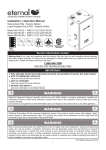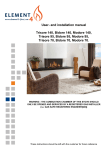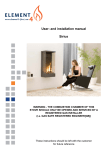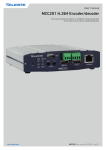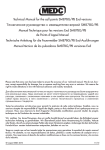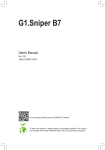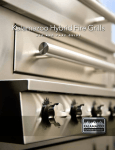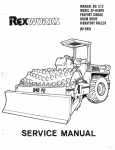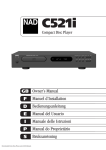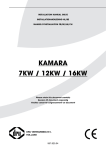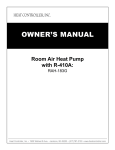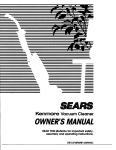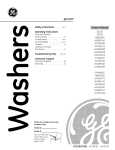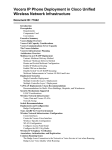Download and installation manual: Lucius 140 CR 1/3
Transcript
User- and installation manual Lucius 140 T, Lucius 140 R Lucius 140 CR 1/3, Lucius 140 CR 2/3 WARNING - THE COMBUSTION CHAMBER OF THIS STOVE SHOULD ONLY BE OPENED AND SERVICED BY A REGISTERED GAS INSTALLER (i.e. GAS SAFE REGISTERED ENGINEER[GB]) These instructions should be left with the customer for future reference This Manual Covers the following appliances: Lucius 140 T, Lucius 140 R, Lucius 140 CR 1/3, Lucius 140 CR 2/3 Contents GENERAL INFORMATION............................................................................................................3 Important Safety Notice..................................................................................................................3 General Fitting Information....................................................................................................4 USER INFORMATION...................................................................................................................5 Remote Control Electronic Ignition System RCE GV60................................................................5 INSTALLER INFORMATION.......................................................................................................10 Ventilation............................................................................................................................10 General Balanced Flue Notes / Appliance Fireplace installation.........................................10 Terminal Locations Wall Mounting.......................................................................................12 Terminal Locations Roof Termination...................................................................................13 Concentric Flue Parts Identification.....................................................................................14 Flue restrictor.......................................................................................................................21 Wall Terminal Terminations..................................................................................................22 Vertical Roof Terminations...................................................................................................23 Installing Remote Control Electronic Ignition System GV60........................................................26 Arranging The Ceramic Fire-bed..................................................................................................27 Log Arrangements...............................................................................................................27 Gravel Arrangements...................................................................................................................30 COMMISSIONING THE APPLIANCE..........................................................................................30 Installing the fire ..IMPORTANT INSTALLATION TIPS............................................................31 Servicing Instructions...................................................................................................................34 Troubleshooting............................................................................................................................35 TECHNICAL INFORMATION.......................................................................................................37 Dimensions...................................................................................................................................37 Technical Details..........................................................................................................................41 Warranty.......................................................................................................................................44 2 GENERAL INFORMATION Important Safety Notice ing regulations. It is therefore recommend that a registered gas installer be employed for this task. The engineer will provide you with information about the safety limits of the installation and should fix a notice plate in a place where it can be readily seen. This appliance has a ceramic Fire-bed arrangement; this contains Refractory Ceramic Fibres, which are man-made vitreous silicate fibres. Excessive exposure to these materials can cause irritation to eyes, skin and respiratory organs. Hence we recommend that when handling these materials the release of dust should be kept to a minimum. During installation and servicing we recommend that a HEPA filtered vacuum be used to remove any dust and soot in and around the fire. If any of the ceramic fire-bed components need to be replaced we recommend that the removed parts be sealed in a heavy-duty polythene bag, and be labelled as RCF waste. RCF is not “Hazardous waste” and can be disposed of at a licensed tipping site for the disposal of industrial waste. This appliance is designed as an efficient heating device and consequently all body parts become very hot in use. Except for the control knob and control access door, which are designed to stay cool, all other parts are working surfaces and should not be touched. The glass and frame on this appliance acts as a fireguard conforming to BS: 1945 – 1971 and satisfies the Heating Appliance (Fireguards) regulations 1991. No part of the window or frame should be permanently removed. It does not give protection for young children aged or infirm, extra guarding(conforming to BS8423: 2002) should be considered so the special hazards that exist in nurseries and other places where there are young children, aged or infirm persons are minimized. The appliance incorporates a permanent pilot. This is located on the front of the burner, and must not be adjusted by the installer. This system must not be put out of operation, and if any parts require changing, only original manufacturer parts shall be used. Bearing in mind that the heat given off by this appliance may affect articles placed close to it, curtains should not be placed within 30cm. This appliance is designed to be used either Natural or LPG gas however, each individual appliance is only capable of running off the type of gas specified at the time of purchase. It is important to note that once a type of gas has been specified the stove cannot run off any other type. The type of gas that your stove is capable of burning is stated on the data information panel. The appliance is not designed as a dryer. It is not therefore recommended that the appliance be used in such a manner. Do not place any articles within 30cm of this appliance as this may result in damage to the articles. This appliance has been designed, tested and approved to meet standards in place for product use, performance and safety. Installation of your appliance must comply with current build- The installation must be carried out in accordance with the following regulations: The Building Regulations issued by the Depart 3 GENERAL INFORMATION General Fitting Information ment of the Environment, the Building Standards (Scotland) (Consolidation) Regulations issued by the Scottish Development Department. Inlet pipe connection 8mm compression Chimney requirements Balanced Flue Flue monitor Permanent Pilot BS 5440 part 1, BS 5871 part 2 and BS 6891. User control: Variable rotary control inc. integrated Piezo ignition, Permanent pilot facility, Flame failure device and Oxygen Depletion Cut-out. In the Republic of Ireland the installation must also conform to the relevant standards, particularly in regard to flue sizing and ventilation. Refer to documents IS813, ICP3, IS327 and any other rules in force. Before installation of these appliances, the area into which the fire is to be fitted must be cleared of all debris (including dust), in particular combustible material. This appliance must be installed in accordance with the rules in force and used only in a sufficiently ventilated space, and is intended for use on a gas installation with a governed meter. The appliance must sit on a hearth (or base surface) sufficient to support the weight of the fire. The firebox must then also be secured. Adjustable brackets are supplied on the firebox for this purpose. Before installation, ensure that the local distribution conditions (identification of the type of gas and pressure) and the adjustment of the appliance are compatible. The technical specification of this appliance is given on the rear page of this manual. Prevention of rust: Always switch the Fire completely off after use. This saves gas and prevents corroding of your fire. Do not use the appliance if the glass front door or panel has been broken, removed or is open. Note: Since the appliance is a source of heat, circulation of air occurs. Therefore it is of importance that you do not use the appliance shortly after a renovation of the home. Because of the natural circulation of air, moist and volatile components from paint, building materials, carpet etc. will be attracted. These components can settle themselves down onto cold surfaces in the form of soot. 4 Remote control electronic ignition system RCE GV60 - temperature display in degrees Celsius or Fahrenheit; - time; thermostat function; The appliance supplied with a remotesyscontrol. - -temperature display in degrees Celsius or Remote control is electronic ignition - temperature in degrees Celsius or - timer for display thermostat function. Remote control ignition Ignition, controllingelectronic the flame height and switchFahrenheit; tem RCE GV60 Fahrenheit; system GV60 by the remote control that ing offRCE are performed - time; - time; the function; communication code operates a the control control. hatch. For - Setting thermostat The appliance is receiver supplied in with a remote - thermostat function; the application The some appliance is supplied with a remote appliances, control hatch isswitchsupplied. - Prior timerto forputting thermostat function. into operation, a Ignition, controlling the no flame height andcontrol. - timer for thermostatcode function. communication must be set between the Ignition, controlling theby flame height and switchIn are that case, the receiver is placed under ing off performed the remote control that the USER INFORMATION USER INFORMATION remote control and the receiver. The code is choing off are performed by control the remote control that are Setting appliance. Theinreceiver andhatch. remote the communication code operates a receiver the Forcontrol some Setting communication codeavailable sen the randomly from the 65000 codes.a operates a no receiver thereceiver control hatch. battery powered. The requires 4 Prior to putting the application into operation, appliances, controlin hatch is supplied. In For that Prior toaputting application into operation, a the As result, the chance that other remote controls some appliances, control hatch supplied. penlite (AA type) batteries, the control communication code must be set between case, the receiver isno placed under theisremote appliance. communication be set between the near you arecode using the receiver. same code and affect the In that case,and the receiver is placed underpowthe the requires 3 xremote AAA penlites .At battery normal use, remote control andmust the The code is choThe receiver control are remote control of and the appliance receiver. codesmall. iscodes. cho- As operation your is very appliance. The receiver and control areyear. batteries will have an average of one sen randomly from the 65000The available ered. The receiver requires 4 remotelife senarandomly from the 65000 available codes. battery powered. receiver 4control You(AA cantype) also The use an optional adapter. Ask your result, the chance that other remote controls penlite batteries, therequires remote As anear result, chance other remote controls Follow the procedure penlite (AA batteries, the remote control installer for information. Innormal that case you youthe are using that the described same codebelow: and affect the requires 3 xtype) AAA penlites .At use, the will you are using the same code and affect the Hold down the reset button on the receiver, requires 3 xhave AAA penlites .Atnear normal use, the near needwill a 230 V connection your appliance. operation of your appliance is very small. batteries an average life of one year. of your is very small. until you hearappliance two consecutive sound signals batteries will use havean anoptional averageadapter. life of one You can also Askyear. your operation (see fig. After the second,below: longer signal, You canfor also use an optional your Follow the2). procedure described installer information. In that adapter. case youAsk will need procedure described below: let the godown of thethe reset button. for information. In that case you will Follow Hold reset button on the receiver, ainstaller 230 V connection near your appliance. down the reset on thesound receiver, Press button need a 230 V connection near your appliance. Hold until you hear two button consecutive signals until youfig. hear consecutive sound signals (see 2).two After the second, longer signal, let (see fig. 2). After second, longer on control within 20signal, seconds, go ofthe theremote resetthe button. let Press go of the until youreset hearbutton. a sound signal: this is the button Press button confirmation of a correct communication. !Caution When installing a new remote conon the remote control within 20 seconds, until on you the remote control within 20 trolhear or receiver, you must set a seconds, newconfirmacommua sound signal: this is the until you a sound signal: this is the nication code. tion of ahear correct communication. confirmation of a correct communication. !Caution When installing a new remote control !Caution When you installing a new remote conor receiver, must set a new communicatroltion or receiver, The appliance’s standard functions such as ignicode. you must set a new communication code. tion, controlling the flame height, standby (pilot 1 1 burner) position and switching off ,are performed in the MAN position. the display of as theigniremote The appliance’s standardIn functions such The you appliance’s standard functions such as (pilot ignican seethe theflame letters MAN. standby tion, controlling height, tion,In controlling the remote flame height, standby addition, the control canperformed also(pilot be used burner) position and switching off ,are position and switching off ,are performed set aposition. number of the additional functions: inburner) thetoMAN In display of the remote in the MAN In the display of the remote you can seeposition. the letters MAN. can see theremote letterscontrol MAN. can also be used Inyou addition, the addition, the remote controlfunctions: can also be used toInset a number of additional to set a number of additional functions: 2 2 5 5 5 USER USERINFORMATION INFORMATION USER INFORMATION I gI gn ni ti et e t ht hee aappppl li iaannccee aass ffoollll oo w MAN MAN position position w ss :: eet b uet t oanp p AA nn ctethe h ea g a sf o clcontrol o By briefly pressing the SET button, you will MAN position g nSi tSet th l io aon sgas loonwt sr o: l tto By briefly pressing the SET button, you go will Igo button controlled automatically). through the following functions: By briefly pressing the SETfunctions: button, you will go SetON button A Bon gas control to through the following ON(button (button Bisisthe controlled automatically). is is located in thethe control hatch or MAN → the→ TEMPTEMP →functions: TEMP → (P*)TIMER → ON The through following (button Bcontrol is controlled automatically). MAN → TEMP → (P*)TIMER Thegas gascontrol located in control hatch placed under the appliance. MAN → → MAN TEMP → TEMP → (P*)TIMER The isgas isunder located the control hatch or iscontrol placed theinappliance. ✹ where, depending on theon timer setting: → MAN or is placed under the appliance. where, depending the timer setting: (P*) is(P*) displayed ason P1the , P1 where, depending timer is displayed as ,P1 , setting: , P1, P2 , P2 , , P2 . (P*) isP2 displayed , P2 , . as P1 , , P1 P2 . You can go back to the position by by Youalso can also go back to MAN the MAN position pressing the button (large flame)flame) or You can also go back to the MAN position by or Simultaneously pressing the button (large Simultaneouslypress pressthe thebuttons buttons and on remote control. (small flame). pressing theflame). button (large flame) or Simultaneously press buttons (small and onthe thethe remote control. ✹ ✹ (small flame). and on the remote control. Let !Caution - When -pressing the buttonsthe (withbuttons the !Caution When pressing Letgo goofofthe thebuttons buttons when when aa short short sound sound signal indicates that the ignition process exception of the SET button), the transmission !Caution When pressing buttons Let go of the buttonsthat when a short process sound has (with -the exception of thethe SET button), the signal indicates the ignition has started. symbol ) willsymbol appear indicate that signal (with transmission the( exception of the SET the indicates that the ignition process has ( to button), ) will appear to been been started. InIn succession: transmission takingtransmission place the remote transmission symbol ( between ) will is appear toplace been started. indicateis that taking succession: - the continuous signals will will indicate that the control and thetransmission receiver; indicate that is taking place In succession: between the remote control and the receiver; - the continuous signals indicate thatignithe tion process is active; -between The- receiver acknowledges the transmission the remoteacknowledges control and the - the ignition continuous signals will indicate that the The receiver thereceiver; transmission process is active; - a- a short sound signal willwill indicate thatthat thethe ignition with sound signal; - Theareceiver acknowledges process is active; with a sound signal; the transmission ignition short sound signal indicate igniprocess has finished; -with Thea- appliance will automatically enter the sound signal; will automatically enter the - a short signal indicate that the igniThe appliance tionsound process has will finished; the will standby position, if there no transmission for tion -process - Thestandby appliance will automatically the has finished; position, ifisthere is noenter transmission - theappliance appliance willautomatically automaticallyswitch switch through through to the highest position of the main burner, 6 hours. standby position, will automatically throughwhich for 6 hours. if there is no transmission - the appliance to the highest position of theswitch main burner, which will start few seconds. for 6 hours. to the highest ofa a the main burner, which will starttoposition toburn burninin few seconds. Set the remote controlcontrol to the MAN position. will start to burn in a few seconds. Set the remote to the MAN position. Caution - If- the pilot burner is not after Set the remote control to the MAN position. Caution If the pilot burner isburning not burning 3 after ignition attempts, you must close the gas Ignition Caution - If the pilotattempts, burner isyou notmust burning Ignition 3 ignition close the and the installer; Caution - During the ignition are not you Ignition aftertap 3 ignition attempts, must close the Caution - During theprocess, ignitionyou process, gas tapcall and call theyou installer; When allowed operate control buttonprocess, Bcontrol button Caution During theto ignition you gas andigniting call thethe installer; areto-not allowed operate B -tap - When igniting thepilot pilotburner, burner,you youwill will hear hear sound signals. After thethe lastyou short sound sigon gas control manually arethe not allowed operate control button B - When igniting the pilot burner, will hear on the gas to control manually sound signals. After last short sound nal, the main burner should be largely -on Always wait 5wait minutes afterafter the pilot burner the gas control sound signals. last should short sound - Always 5manually minutes the pilot burner signal, the After main the burner be ignited largely within 10 seconds. If be thislargely isIfnot has gone out,5before you re-ignite - Always minutes after there-ignite pilot burner signal, theabout main burner should haswait gone out, before you ignited within about 10 seconds. thisthe is case, you must close the gas tap and warn the appliance; has gone out, before you re-ignite ignited about seconds. If this is and the appliance; notwithin the case, you10 must close the gas tap installer; the appliance; not your the case, youinstaller; must close the gas tap and warn your - If-your the appliance ignites withwith a pop sound, you warn installer; If the appliance ignites a pop sound, must close theignites gas and - If the appliance with a pop you must close thetap gas tap and sound, your installer. youcontact must close the gas tap and contact your installer. 3 B 3 A A contact your installer. !Tip !TipAAlittle littlemotor motorwill willstart start to to run run when when the the burner operates, will be able to hear !Tipmain Amain little motor will startyou toyou run will when burner operates, bethe able to it. main hear burner it. operates, you will be able to B 6 hear 6 6 it. USER INFORMATION Flame height / standby The flame height can be adjusted continuously by using the buttons and Time The display can indicate time. After placing the battery or simultaneously press(large flame) and ing By continuing to lower the flame height, the appliance can be set to the standby position; this means that only the pilot burner will still be burning. Press button (small flame) to lower the flame height and/or to set the appliance in the standby position. Press the button (large flame) to raise the flame height and/or to switch on the main burner from the standby (pilot burner) position. (small flame), the time indication will flash on the display and you will be able to adjust the time. Simultaneously press and until the time indication flashes on the display. Press the button (large flame) to set the hours. Press the button minutes. (small flame) to set the Caution - If you continue to press down button Press OFF to return to the MAN position, or wait for the system to automatically return to the MAN position. (large flame) on the remote control, the main burner should be largely ignited within about 10 seconds. If this is not the case, you must close the gas tap and warn your installer; - If the appliance ignites with a pop sound, you must close the gas tap and contact your installer. Thermostat function Using the thermostat function you can set two temperatures, which can be controlled thermostatically. These temperatures are referred to as day temperature and night temperature. The TEMP and TEMP symbols on the display refer to day and night temperature respectively. The room temperature is compared to the set day/night temperature and then the flame height is automatically controlled in order to reach the set temperature.To be able to use the day/night temperature function, the appliance must be in the standby position. ✹ Switching off Switch the appliance off by pressing the OFF The pilot burner will also go out. button. Temperature display The room temperature can be indicated on the display in degrees Celsius (°C) using a 24 hour clock or degrees Fahrenheit (°F) using a 12 hour clock. Simultaneously press OFF (small flame) appears. and , until the correct display 7 !Caution - Always leave the remote control at the same place, so that the thermostat is able to ‘feel’ the room temperature; - Make sure this place is free from influences such as draught, heat from radiators and direct sunlight. USER INFORMATION Timer for thermostat function Using the timer enables you to set two times per 24 hours for switching on the day temperature and two times per 24 hours for switching on the night temperature. In order to control the night temperature, it should be set to at least 5 °C / 40 °F. If the night temperature is set to the “-- ” position, the appliance will remain in the standby position. The appliance will only switch on at the next switch-on time of the day temperature. The appliance must be in standby position in order to be controlled by the timer. Example By using the Y TEMP function you can keep the day temperature at 20 °C; while you use the 4 TEMP function at night to maintain a temperature of 15 °C. Setting day/night temperature By using the SET button, you will go through the following functions: MAN → TEMP → TEMP → (P*)TIMER → MAN ✹ Briefly press the SET button to enter the TEMP or the TEMP position. Press the SET button until the temperature on the display flashes. Set the required temperature by using the buttons and ✹ Example of switch times You have set a day temperature and night temperature of, for example, 20 °C and 15 °C. P1 TIMER = 7 hours; the temperature will go to 20 °C at 7 am. P1 TIMER = 9 hours; the temperature will go to 15 °C at 9 am. P2 TIMER = 17 hours; the temperature will go to 20 °C at 5 pm. P2 TIMER = 22 hours; the temperature returns to 15 °C at 10 pm. ✹ !Caution - The minimum temperature you can set is 5 °C / 40 °F; - Control of the night temperature is switched off by lowering the temperature until two stripes (“--”) appear on the display. Press the OFF button or wait until position TEMP or TEMP appears on the display. ✹ ✹ Activating the thermostat function For activating the thermostat function, you must proceed with the following steps: Place the appliance in the standby (pilot burner) position using button (small flame). Set the day/night temperature. ✹ Choose the TEMP or the SET button. TEMP function using 8 USER INFORMATION Replacing the battery If the battery is almost empty, the display will show “BATT”. Setting times for the timer To set the timer, proceed as follows: Set the day and night temperature as described above Briefly press the SET button to enter the (P*) TIMER position. Press the SET button until P1 TIMER is displayed and the time flashes. Set the first switch on time of the day temperature To replace the battery, proceed as follows: Remove the cover at the back side of the remote control. Disconnect the 9V block battery from / connect the 9V block battery to the connector. ✹ large flame) and using the buttons (small flame) . Briefly press the SET button to set the next time of the cycle, P1 TIMER. Successively set the times P2 TIMER and P2 TIMER. Press the OFF button or wait until position (P*) TIMER appears on the display. !Caution - Observe the “+” and “-” poles of the batteries and the connector; - Use alkaline batteries; - Batteries are regarded as “small chemical waste” and may therefore not be disposed with the household rubbish. ✹ Place the battery in the holder. Replace the cover. Activating the timer function Follow the steps below for activating the timer control: Place the appliance in the standby (pilot burner) (small flame). position using button Set the day/night temperature if you have not yet done so; Set the timer times P1 TIMER, P1 TIMER, P2 TIMER and P2 TIMER. ✹ ✹ Choose the (P*) TIMER function using the SET button. 9 INSTALLER INFORMATION InstallatIon restricted to the Flue systems as specified by the supplier, thus the appliance must only be installed with the original flue system, no others may be used Before beginning the installation, check that the details on the rating plate correspond to the gas type and pressure to which the appliance will be connected. This appliance can be installed in a completely sealed or mechanically ventilated house without extra ventilation and/or fume extraction. The gas fire, in combination with the concentric flue system , has been approved in accordance with the European CE-norm for gas appliances and may therefore be used only with this system. The guarantee is invalidated if the appliance is (completely or partially) installed using a different system. General Balanced Flue Notes The concentric flue systems can be used with either a newly-built or existing chimney. Ventilation These appliances are designed with the “Firebox” raised up off the ground level by the built in “Base unit”. There are many possibilities for installing this Concentric Balanced Flue system into a building, both Roof and Wall terminations are possible, and the flue can either be built into an existing chimney or a completely new flue system may be constructed. Thus these appliances require no special Hearth arrangements, as the floor will not get hot and is protected by the steel construction of the “Base unit”. The system is based upon a Concentric Flue system which utilises an inner flue of 100 or 130 mm diameter which passes through an outer flue of 150 or 200 mm diameter. The flue gasses that are the products of combustion of the fire, pass through the inner flue and are safely vented to the outside environment. The gap between the inner and outer flues is the channel by which the stove is supplied with air for combustion. The appliance must not be fitted against a rear wall constructed from a combustible material; a gap of 300mm should be given all round the stove before combustible materials may be used in the wall construction. If the appliance has to be located in an opening, a minimum clearance of 50mm should be allowed to non-combustible materials. These concentric flues terminate outside of the property in a terminal, this terminal will keep the expelled gasses and the fresh air for combustion separate. It is important that the terminal is not blocked, a suitable guard maybe required if the terminal is located at a “Low” level (usually when the terminal is within 2m of floor level). If the appliance is located in a recess, then the recess must have adequate ventilation, we recommend a minimum total vent area of 400 cm². The stove must be located at least 300 mm from any combustible materials outside the chimney breast. The Balanced Flue gas appliance can be installed as an insertion into an existing or new fireplace. If an existing Flue or Chimney is to be utilised, then the installation engineer must be consulted. If the chimney has been previously used it must be professionally cleaned and certified as being sound and fit for use. Appliance Fireplace Installation After selecting the appliance location, install a gas connection for the appliance in approximately the desired location of the gas controls. The European CE approval on this appliance is The gas controls are already connected to the 10 INSTALLER INFORMATION appliance. The controls need to be located in the control access box, so an appropriate position for the access box need to be determined. This appliance has adjustable legs, these must me set to stabalise the fire before flue position is finalised. completely open and unobstructed sides. The distance between the lowest part of the roof and the top of the terminal should be at least 600mm. Note: A covered passageway should not be treated as a carport. Flues should not be sited in a covered passageway between properties. Do not make any adjustments to the appliance, except the leg length. Basements,Lightwells and Retaining walls The appliance and Flue system should be fitted with a minimum clearance of 500mm from any combustible objects or materials, this includes any combustible materials used for the fireplace construction. Flue terminals should not be sited within the confines of a basement area, light well or external space formed by a retaining wall, unless steps are taken to ensure the products of combustion can disperse safely at all times. It may be possible to install this Balanced Flue system in such a location provided that it is not sited lower than 1m from the top level of that area to allow combustion products to disperse safely. As this is a room sealed appliance and the appliance stands on appropriate legs, a hearth is not required for this appliance. The Fireplace should be ventilated with openings giving a total free vent area of 400 cm². Flue terminals should be sited to ensure total clearance of the combustion products in accordance with the inclosed information. A gap of 50mm should be left all round the appliance. When the products of combustion are discharged, they should not cause a nuisance to adjoining or adjacent properties and they should be positioned so that damage cannot occur to other parts of the building. If the outer wall surface is constructed of combustible material, a non-combustible plate should be fitted behind the terminal projecting 25mm beyond the external edges of the terminal. If a shelf is to be fitted above the fireplace opening, a gap of 150mm minimum should be left between the opening and the shelf. The brackets supplied may be used fore securing the appliance to a rear wall. Timber Frame Construction Whilst it is possible to install room-sealed appliances in timber frame properties, great care needs to be taken to ensure that the flue assembly does not interfere with the weather proofing qualities of any outer wall which it may penetrate. Before attempting this work, further details need to be referenced, (e.g. “Gas Installations in Timber Frame Buildings” from the CORGI installer series in the UK). Carport or Building Extension Where a flue terminal is sited within a carport or building extension, it should have at least two 11 INSTALLER INFORMATION INSTALLER INFORMATION Terminal Locations Wall Mounting Dimension TerminalTerminal PositionPosition Dimension A* below anbelow opening,air brick, opening window window etc. A*Directly Directly an opening,air brick, opening etc. B DistanceDistance (mm) (mm) 600 600 opening,air brick, opening window window etc. BAbove an Above an opening,air brick, opening etc. Adjacent to an opening,air brick, opening window etc. C Adjacent to an opening,air brick, opening window etc. 300 300 400 400 soil pipes orpipes drain or pipes DBelow gutters, Below gutters, soil drain pipes EBelow eaves Below eaves 300 300 300 300 of car port roofport roof FBelow balconies Below balconies of car pipe or soil GFrom a vertical From a drain vertical drain pipepipe or soil pipe 600 600 300 300 600 600 I internal external corner corner HFrom anFrom an or internal or external or balcony level I Above ground Above roof ground roof or balcony level 300 300 J terminal JFrom a surface From a facing surfacethe facing the terminal 600 600 K facing the terminal 600 KFrom a terminal From a terminal facing the terminal opening in the car (e.g.port door , window into the dwelling) LFrom anFrom an opening in port the car (e.g. door , window into the dwelling) 1200 600 C D E F G H L M N P Q 1200 from a terminal on the same wall MVerticallyVertically from a terminal on the same wall Horizontally from a terminal on the same wall N Horizontally from a terminal on the same wall 1500 1500 300 300 on the roof PFrom a vertical From a structure vertical structure on the roof with roofwith roof QAbove intersection Above intersection 600 600 150 150 * I addition, the terminal should not be nearer than 300mm to an opening in the building fabric * I addition, the terminal should not be nearer than 300mm to an opening in the building fabric formed for the purpose of accomodating a built in element such as a window frame. formed for the purpose of accomodating a built in element such as a window frame. 12 12 INSTALLER INFORMATION Terminal Locations Roof Termination “Distance” = minimum distance required for positioning of the outlet to avoid adverse effects with respect to: A. A ventilation opening serving an occupied room, a toilet or a bathroom B. A heating air supply, when the supply flows through an occupied room. C. A window that can be opened and that is near an occupied room, a toilet or a bathroom. To avoid adverse effects (*) Distance: outlet A,B or C At the same roof level >6 m (*) At a different roof level >3 m (*) (**) At a lower positioned wall >2 m (**) At a higher sloping surface >6 m (***) If the required distance cannot be achieved, the outlet position rules take precedence. (**) If the outlet is positioned at least 1 m higher than the intake supply opening, or a window that can be opened. (***) If the required distance cannot be achieved, the position of the outlet must be at least 1 m above the highest facade/roof. Important note for Roof Terminations (C31). When installing the appliance with a roof termination (classification C31), it is important to fit a flue restriction strip across the flue outlet inside the stove, see notes page 21. Minimum Vertical Length notes. Roof terminations may be installed from a minimum height 1.0 m this is shown on the pages that follow. 13 INSTALLER INFORMATION Concentric Flue Parts Identification The following pages identify the parts that may be used in the Balanced Flue installation of this appliance. The Item number in the table refers to the item number of the part in the Identification pages, this Item number is also the number that will be used to identify parts in the Installation suggestion diagrams. Item Description A B C D E F G 1 2 3 4 5 6 7 8 9 10 11 12 13 14 15 16 Appliance Appliance Connector Flue Adaptor Chimney or Flue, Fully Gas Tight Ø150 minimum Chimney or Flue, Fully Gas Tight Ø160 minimum Stainless Steel Flexible Chimney Liner Ø100, AISI 316Ti Stainless Steel Flexible Chimney Liner Ø150, AISI 316Ti Concentric Flue Pipe 250mm Length Concentric Flue Pipe 500mm Length Concentric Flue Pipe 1m Length Locking Band Protection Band Concentric Flue Pipe Adjustable Length 50 - 300mm Vertical Terminal Horizontal Terminal (Excentric Exit) Ø100 Mounting Band Wall Band Adjustable Concentric Flue 90° Concentric Flue 45° Concentric Flue 15° Storm Collar Flat Roof Flashing (Aluminium) Flat Roof Flashing 18 19 20 21 22 23 24 25 Slope Roof Flashing 5° - 30° Slope Roof Flashing 20° - 45° Adjustable Roof Plate (Supplied as pair) Wall Cover Flue reducer Ø130 - Ø100 Horizontal Terminal (Excentric Exit) Ø130 Concentric Flue 90° with Inspection Cover Inspection Element 14 Ø100 Part No. US 25 100 US 50 100 US 100 100 USKB 100 USAB 100 USPP 100 USDVC2 100 USDHCE 100 USEB 100 USMB 100 USB 90 100 USB 45 100 USB 15 100 USSR 100 USDPAL 100 USDP 100 USDH 100 USLS 100 USCP 100 USMPG 100 USBI 100 USI 100 Ø130 US 25 130 US 50 130 US 100 130 USKB 130 USAB 130 USPP 130 USEB 130 USMB 130 USB 90 130 USB 45 130 USB 15 130 USSR 130 USDPAL 130 USDP 130 USDH 130 USLS 130 USCP 130 USMPG 130 USVK 10 130 USDHC 130 USBI 130 USI 130 INSTALLER INSTALLERINFORMATION INFORMATION 15 15 INSTALLER INSTALLERINFORMATION INFORMATION 16 16 INSTALLERINFORMATION INFORMATION INSTALLER 17 17 INSTALLER INSTALLER INFORMATION INFORMATION 18 18 INSTALLER INFORMATION INSTALLER INFORMATION 22 USVK 100 130 REDUCER Ø130 - Ø100 23 USDHC 130 HORIZONTAL TERMINALØ130 19 INSTALLER INFORMATION INSTALLER INFORMATION 24 USBI 100 130 Elbow 90° with inspection cover 25 USI 100 130 Inspection Element 20 20 INSTALLER INFORMATION FLUE RESTRICTOR - When using Flue system (200/130) with a wall terminal DON’T use any restrictor - When using Flue system (200/130) and vertical is > 1.25 m and then direct through the wall (and no more horizontal) use flue restrictor 35 mm. - When using a roof terminal Flue system (150/100) and vertical is between1.25 m and 2.0 m use restrictor 35 mm. - When using a roof terminal Flue system (150/100) and vertical is > 2.0 m use restrictor 60 mm. The 60 mm Flue restrictor is located on the inside of the Fire near the Flue outlet. Undo 1 of the bolds and turn the restrictor over the flue outlet. The 35 mm flue restrictor is packed seperately with the Fire. 21 INSTALLER INFORMATION Rigid RigidBalanced BalancedFlue FlueConnection ConnectionPossibilities Possibilities Horizontal HorizontalWall WallTermination Termination Lucius Lucius140 140T,T,Lucius Lucius140 140R,R,Lucius Lucius140 140CR CR1/3, 1/3,Lucius Lucius140 140CR CR2/3 2/3 Diameter DiameterConcentric ConcentricFlue: Flue:200/130 200/130 Lucius LuciusFires: Fires: Minimal vertical Minimal verticalheight height“V” “V”isis5050cm cmplus plusbent. bent. Maximum Maximumheight height“V” “V”whilst whilstusing usinga awall wallterminal: terminal:3 3meter meter Horizontal Horizontalpossibilities: possibilities: 0,5 meter 0,5meter metervertical verticalgives givesmaximum maximumhorizontal horizontal0,5 1 meter 1.0 meter vertical gives maximum horizontal 1,0 meter 1.0 meter vertical gives maximum horizontal 2 meter 1,5 meter vertical gives maximum horizontal 1,5 meter 1,5 meter vertical gives maximum horizontal 3 meter 2,0 meter vertical gives maximum horizontal 2,0 meter 2,5 meter vertical gives maximum horizontal 2,5 meter 3,0 meter vertical gives maximum horizontal 3,0 meter 22 22 INSTALLER INFORMATION Vertical Roof Terminations When installing the appliance with a roof termination (classification 31) it is important to fit a flue restrictor across the flue outlet inside the fire. Roof terminations will need the 60 mm flue restrictors fitting. This is delivered with the fire. Distance “V” = 1m– 11m (min – max) We recommend using flue reducer USVK to flue dimension 150/100. 23 INSTALLER INFORMATION Vertical Roof Mounted Termination with Elbow Rigid Concentric Flue Vertical Roof Mounted Termination with Elbow forfor Rigid Concentric Flue We recommend using flue reducer USVK to flue dimension 150/100. 24 24 INSTALLERINFORMATION INFORMATION INSTALLER Vertical VerticalRoof RoofMounted MountedTermination Terminationwith withAngled AngledElbow Elbowfor forRigid RigidConcentric ConcentricFlue Flue We recommend using flue reducer USVK to flue dimension 150/100. 2525 INSTALLER INSTALLERINFORMATION INFORMATION Installing the controls Installing the controls Electronic Ignition System RCERCE GV60) Electronic Ignition System GV60) This requires no external electrical powerpower to This requires no external electrical to operate. The receiver unit hasunit onlyhas oneonly lead.one Thislead. operate. The receiver lead has plug. Thisplug. plugThis fits into Thisone leadsingle has one single plug the fits into connector block on block the front of the Control the connector on the frontGas of the Gas Conunit, the of this plug is important. trolorientation unit, the orientation of this plug is important. InstallInstall the batteries into the and and the the the batteries intoreceiver the receiver handset; these these will bewill 4 x 1,5V alkaline handset; be 4AA x 1,5V AA and alkaline 3 x AAA andalkaline 3 x AAArespectively. alkaline respectively. Setting the electronics code:code: Setting the electronics The receiver has to has select code the handset, The receiver to the select theofcode of the handpleaseset, follow the follow procedure: please the procedure: 1) Power up handset 1) Power up handset 2) Power up receiver (LED (LED flashes) 2) Power up receiver flashes) 3) Push “reset”“reset” buttonbutton on receiver till long 3) Push on receiver tillbeep long beep 4) Push “flame“flame low” button on sender till short 4) Push low” button on sender till short beep beep 5) Gas5)fire isfire nowis ready for ignition. See See options Gas now ready for ignition. options in userinpart. user part. The receiver unit can becan hidden away under The receiver unit be hidden away or under behind stove, that thethat receiver is or the behind theensure stove, ensure the receiver located in an area thatarea hasthat a temperature beis located in an has a temperature low 60ºC, and that the where below 60ºC, andcustomer that the knows customer knows the receiver future battery replacement. where is theforreceiver is for future battery replacement. Check the system. Check the system. 26 26 INSTALLER INFORMATION Log Arrangements - Lucius 140 Only the ceramics supplied with this appliance are to be used. The ceramics must be laid only as shown on this page. Replacement parts are available from your dealer, but should only be installed by a qualified installation engineer. Ensure that the grate is sitting firmly in the base of the fire box, with the long slot in the centre of the Grate aligning with the centre slots on the Burner. The Pilot flame must be visible through the grate and the cut-out in the Pilot Shield. 27 INSTALLER INFORMATION 28 INSTALLER INFORMATION Please make sure that pilot area and second pilot couple area are completely free of any ceramic materials. Finally check if the cross lighting of pilot flame to main burner is correct before the glass is being placed! 29 Gravel Arrangements / Blackstones / Brilliants Commissioning the appliance A soundness test MUST be made before the INSTALLER INFORMATION installed stove is left with the customer. Ensure that the Grate , is sitting firmly in the base of the fire box, with the long slot in the centre of the Grate aligning with the centre slots on the Gravel Arrangements / Blackstones / Burner Tube. The Pilot flame must be visible Brilliants through the Ensure that the Grate , is sitting firmly in the base grate and the cut-out in the Pilot Shield. of the fire box, with the long slot in the centre of the Grate aligning with the centre slots on the Burner Scatter evenly the Gravel over the top of the Tube. The Pilot flame must be visible through the Grate and Burner. Make sure that some holes grate and the cut-out in the Pilot Shield. of grate are still visible. Ensure that none of the gravel enters the pilot enclosure. Scatter evenly the Gravel over the top of the Grate and Burner. Make sure that some holes of grate are still visible. Ensure that none of the gravel enters the pilot enclosure. Commissioning the appliance Ensure that the fire is burning at full rate for a minimum of 5 minutes to warm the flue. A soundness test MUST be made before the installed stove is left with the customer. If there are problems, the flue may require attention. Ensure that the fire is burning at full rate for a minimum of 5 minutes to warm the flue. The stove will produce an odour and/or smoke for the first few hours of use. Please ventilate If there are problems, the flue may require the room. Also please note that during this initial attention. burning period, a grey dust deposit will be formed on the inside of the window, please clean this The stove will produce an odour and/or smoke before leaving the appliance with the customer. for the first few hours of use. Please ventilate the room. Also please note that during this initial burning period, a grey dust deposit will be formed on the inside of the window, please clean this before leaving the appliance with the customer. Gravel Arrangement The Gravel arrangement is now complete, HowThe Gravel arrangement is now complete, However, it is important to check that no stones ever, it is important to check that no stones have entered the pilot area and the cross have entered the pilot area and the cross lighting is good before the glass is replaced. lighting is good before the glass is replaced. The LPG log arrangement is now complete, However, it is important to check that the Pilot Flame is still visible. 30 30 INSTALLER INFORMATION INSTALLATION TIPS Please read first the general fitting information which one can find on page 4 of this booklet. IMPORTANT INSTALLATION TIPS FALSE CHIMNEY BREAST: The false chimney breast must always be constructed of an non-combustible material; Always ventilate the space above the appliance by means of grills or a comparable alternative with a minimum air supply of 400 cm2; For the finish, use special stucco (min 100 degrees C resistant) or glass fibre wallpaper to prevent discoloration or cracks; The false chimney breast and its construction may not rest on the appliance. Always use a lintel if the chimney breast is constructed of brickwork. These should not be placed directly on the appliance. IMPORTANT: EXTENSION DUE TO HEAT: Due to the heat the frame of the fire will extend Always keep in mind that the topframe of the appliance must be able to rise a bit, e.g. make the false chimney breast wider and leave some mm space between breast and frame. In order to limit the extension to max 5 mm, it is important to loose the two red travel nuts with one full swing, at the moment the appliance has been reached its final position. The red nuts (one at each side can be reached between the glass and frame. (see next page) 31 INSTALLER INFORMATION INSTALLER INFORMATION INSTALLER INFORMATION TENTION ! - TRAVEL LOCK NUTS - RED. ! ATTENTION ! - TRAVEL LOCK NUTS - RED. ! ATTENTION ! - TRAVEL LOCK NUTS - RED. re two travel locking nuts (one either side) There are two travel locking nuts (one either side) must be releasedThere by one before thenuts appliance is fired. areturn twoeach travel locking (one either side) These must be released by one turn each before the appliance is fired. These must be released by one turn each before the appliance is fired. en kunnen ook bereikt De bouten kunnenworden ook bereikt worden het glas en het frame. De bouten tussen het glas en het kunnen frame. ook bereikt worden tussen het glas en het frame. 32 32 32 INSTALLER INFORMATION INSTALLATION OF THE GLASS WINDOW Remove the window trims left, right and bottom like shown in figure 1, 2, 3 Figure 1 Figure 2 Figure 3 Unscrew the crosshead screws and remove the metal clamps which hold the glass window in place (top and bottom glass window). See figure 4. Figure 4 Figure 4 Figure 5 Now remove the glass window by lifting the glass and then bring it forward. See figure 5. When the glass window is placed back again, DON’T tighten the screws of the metal clamps too tight. This brings tension and might cause the glass window to break. 33 SERVICING SERVICINGINFORMATION INFORMATION servicing instructions servicing instructions Troubleshooting Troubleshooting The The following outlines only the minimum work that following outlines only the minimum work should be performed on an annual basis. This that should be performed on an annual basis. service like any other the appliance, Thiswork, service work, likework anyon other work on the mustappliance, only be done by a qualified and competent must only be done by a qualified and engineer who isengineer Gas Safe registered. competent who is Gas Safe registered. Open the door and remove all Open the door and removeceramics. all ceramics. Remove Grate fromfrom the firebox. Remove Grate the firebox. Remove any debris from the the top top of the burner Remove any debris from of the burner usingusing a vacuum cleaner and and brush. a vacuum cleaner brush. Inspect the burner unit. Inspect the burner unit. Perform an ignition check. Perform an ignition check. Perform a flame failure check Perform a flame failure check There should be no to service the burner. If There should beneed no need to service the burner. however this is required, then the engineer If however this is required, then the should engineer check the setting pressure inlet to burner; should check the settingatpressure at inlet to the correct pressure is shown at the rear therear burner; the correct pressure is shown atofthe manual. of the manual. Brush off and replace ceramic arrangement as as Brush off and replace ceramic arrangement earlier in this manual, replacing anyany broken or or earlier in this manual, replacing broken damaged pieces. damaged pieces. Check all seal on door glass)glass) and re-and Check all seal on (including door (including placereplace the Door. the Door. Check the installation for gas Check the installation for leaks. gas leaks. Check flue for clearance of products of combusCheck flue for clearance of products of combustion.tion. On On the the next next pages pages you you will will find find remedies remedies for for problems which may accur when using fires problems which may accur when using fires with with full full electronic electronic ignition ignition RCE RCE GV60 GV60 If any partsparts need to be useuse onlyonly genuIf any need to replaced be replaced genuine manufacturer parts, non-standard parts will ine manufacturer parts, non-standard parts will invalidate the guarantee andand maymay be dangerous. invalidate the guarantee be dangerous. 3434 Figures Figures troubleshooting troubleshooting Figure 1 A Figure 2 TROUBLE SHOOTING "Problem” "Possible cause” "Remedy” A. No transmission (motor will not run) 1. The (new) communication code between receiver and remote control must still be confirmed. 1. Hold down the reset button of the receiver, until you hear a long beep . Let go of the reset button after the second, longer sound signal and press button (small flame) on the remote control within 20 sec., until you hear a sound signal confirming that the new code has been set. 2. Replace batteries. !Caution Avoid short circuit between the batteries and metal parts of the appliance. 3. Replace the receiver and confirm the code (remedy 1). 4. Replace the remote control and confirm the code (remedy 1). 5. Replace the motor cable. 6. Make sure that the pins of the 8-wire connector are straight. 7. Change the position of the antenna. 2. Empty batteries. 3. Receiver is damaged. 4. Remote control is damaged. 5. Motor cable at valve/receiver is broken. 6. Bent pins of the 8-wire connector. 7. If the receiver is surrounded by metal, this could decrease the transmission range. B. No ignition (spark) 1. Button A in position MAN. 2. Ignition cable runs over and/ or alongside metal parts. 3. Ignition pen corroded. 4. 60-second delay before the full restart is not yet finished. 1. Receiver is damaged. C. No sound signal D. One continuous sound signal of 5 sec. (Possible 7 short beeps prior to the 5 sec. sound signal) 2. 60-second delay before the full restart is not yet finished. 1. Loose wiring between receiver and gas control. 2. Receiver is damaged. 3. Bent pins of the 8-wire con- nector. 4. Damaged magnetic valve. 1. Air in the pilot burner pipe. E. No pilot burner flame 2. Wires of thermocouple have been cross-connected. 3. No spark at the pilot burner. 4. Injector is blocked up. 35 1. Switch button A on the gas control to ON (figure 1) 2 Do not place the ignition cable over and/or along metal parts. This will weaken the spark; If necessary, replace the ignition cable. 3. Replace the ignition pen. 4. Wait until the delay time has passed. 1. Replace the receiver and confirm the code (remedy 1 at A) 2. Wait until the delay time has passed. 1. Connect the wiring properly. 2. Replace the receiver and confirm the code (remedy 1 at A) 3. Make sure that the pins of the 8-wire connector are straight. 4. Replace the gas control. 1. Flush the pipe or start the ignition process several times. 2. Check the polarity of the thermocouple wiring. Connect the thermocouple wiring properly, if necessary. 3.1 Check if the ignition cable is lying free from metal parts; If necessary, move it away from the metal parts. 3.2 If necessary, replace the ignition cable. 3.3 If necessary, replace the ignition pen. 4.1 Clean the injector. 4.2 If necessary, replace the injector. TROUBLE SHOOTING “Problem” “Possible cause” F. Electronics keep sparking while the pilot burner is ignited 1. Receiver is damaged. 1. Replace the receiver and confirm the code (remedy 1 at A) G. Pilot burner is burning, but magnetic valve closes after ca. 10 seconds or when the appliance gets hot 1. Thermocouple does not function. 1.1 Measure the voltage, using a digital mul- timeter, set to mV range, by connecting the cables to the cable shoe. The cable shoe is located on the outside, directly next to the magnet nut at the rear of the gas control; The voltage should be at least 5mV within 20 seconds. It may not be lower when the appliance is warm. If the voltage is too low: - the thermocouple should be placed bet- ter in the flame or - the thermocouple should be replaced. 1.2 Check the size of the pilot burner flame. Correct a flame that is too small. 1.3 Check the wiring of the thermocouple to the receiver. If necessary, replace the wiring. 2. Replace the receiver’s batteries. !Caution Avoid short circuit between the batteries and metal parts of the appliance. 2. Batteries (almost) empty. H. There are short sound sig- nals, but no sparks and no sound / clicks can be heard of the magnet opening the valve I. Pilot burner is burning, but there is no gas flow to the main burner 1. Batteries (almost) empty. 1. Button A in position MAN. 2. Appliance in the pilot flame position. 3. Pre-pressure of the gas is too low. J. Main burner ignites, but goes out again after approx. 22 seconds 4. Damaged magnetic valve. 1. Wiring of 2nd thermocouple is loose. 2. Wires of 2nd thermocouple have been cross-connected. 3. Short-circuit in the wiring of 2nd thermocouple 4. Broken wire in the wiring of thermocouple 5. 2 nd Thermocouple is dirty. 6. 2 nd Thermocouple is not positioned correctly in the flame 7. 2 nd Thermocouple is defective. 8. Receiver is defective. 36 “Remedy” 1. Replace the receiver’s batteries. !Caution Avoid short circuit between the batte- ries and metal parts of the appliance. 1. Turn button A on the gas control to ON 2. Increase the flame height by pressing button (large flame) on the remote control. 3. Check pre-pressure. If necessary, contact gas company. 4. Replace the gas control. 1. Connect the wiring properly.(figure 2) 2. Connect the wiring properly. (figure 2) 3. Replace wiring. 4. Replace wiring. 5. Clean the thermocouple. 6. Position the thermocouple correctly in the flame. 7. Check the voltage across thermocouple just before the main burner goes out. If the voltage is lower than 1.8 mV, replace thermocouple 8. Check the voltage across thermocouple just before the main burner goes out. If the voltage is higher than 1.8 mV, replace the receiver. TECHNICAL INFORMATION Technical drawings Lucius 140 R 394 1532 364 288 422 426 626 172 1417 1419 1547 15 1419 364 36 1419 304 1386 172 834 804 1386 1417 180 200 170 422 626 345 15 1419 37 TECHNICAL INFORMATION Lucius 140 CR 1/3 394 1532 288 1417 304 517 519 1547 1419 364 36 1419 486 422 426 626 1386 172 170 834 804 200 170 422 345 626 180 364 519 38 TECHNICAL INFORMATION Lucius 140 CR 2/3 394 364 288 834 804 1386 1417 304 947 949 1547 1419 364 1419 916 422 426 626 180 200 36 422 626 345 172 170 1532 949 39 TECHNICAL INFORMATION Lucius 140 T 394 364 288 304 1405 1409 1409 422 426 626 1370 172 170 1370 1405 180 200 1552 1409 364 36 422 626 345 834 804 1552 1409 40 TECHNICAL INFORMATION Countries of Destination The following table gives detail of the Countries that these appliances are approved for use within. The tables following immediately on give the technical characteristics of the appliances. AT BE CH CZ Austria Belgium Switzerland Czech Republic DE DK EE ES FI FR GB GR HR HU IE IT LT LU LV NL NO PL PT RO SE SL SK TR Germany Denmark Estonia Spain Finland France United Kingdom Greece Croatia Hungary Ireland Italy Lithuania Luxembourg Latvia The Netherlands Norway Poland Portugal Romania Sweden Slovenia Slovakia Turkey Natural ü I2H G20@20mbar ü I2E+ G20/G25@20/25mbar ü I2H G20@20mbar ü I2H G20@20mbar ü ü ü ü ü ü ü ü ü I2E G20@20mbar; I2ELL G20/G25@20mbar I2H G20@20mbar I2H G20@20mbar I2H G20@20mbar I2H G20@20mbar I2E+ G20/G25@20/25mbar I2H G20@20mbar I2H G20@20mbar I2H G20@20mbar ü ü ü ü ü ü ü ü ü ü ü ü ü ü I2H G20@20mbar I2H G20@20mbar I2H G20@20mbar I2E G20@20mbar I2H G20@20mbar I2L G25@25mbar I2H G20@20mbar I2E G20@20mbar I2H G20@20mbar I2H G20@20mbar I2H G20@20mbar I2H G20@20mbar I2H G20@20mbar I2H G20@20mbar 41 TECHNICAL INFORMATION AT BE CH CY CZ DE DK EE ES FI FR GB GR HR HU IE IT LT LU LV MT NL NO PL PT RO SE SL SK TR Austria Belgium Switzerland Cyprus Czech Republic Germany Denmark Estonia Spain Finland France United Kingdom Greece Croatia Hungary Ireland Italy Lithuania Luxembourg Latvia Malta The Netherlands Norway Poland Portugal Romania Sweden Slovenia Slovakia Turkey LPG ü I3B/P G30/G31@50mbar ü I3+ G30/G31@28-30/37mbar ü I3B/P G30/G31@50mbar, I3+ G30/G31@28-30/37mbar ü I3B/P G30/G31@30mbar ü I3B/P G30/G31@50mbar, I3+ G30/G31@28-30/37mbar ü I3B/P G30/G31@50mbar ü I3B/P G30/G31@30mbar ü I3B/P G30/G31@30mbar ü I3+ G30/G31@28-30/37mbar ü I3B/P G30/G31@30mbar ü I3B/P G30/G31@30mbar, I3+ G30/G31@28-30/37mbar ü I3B/P G30/G31@30mbar, I3+ G30/G31@28-30/37mbar ü I3B/P G30/G31@30mbar, I3+ G30/G31@28-30/37mbar ü I3B/P G30/G31@30mbar ü I3B/P G30/G31@30mbar ü I3+ G30/G31@28-30/37mbar ü I3+ G30/G31@28-30/37mbar ü I3B/P G30/G31@30mbar ü I3B/P G30/G31@30mbar ü I3B/P G30/G31@30mbar ü I3B/P G30/G31@30mbar ü ü ü ü ü ü I3+ G30/G31@28-30/37mbar I3B/P G30/G31@30mbar I3B/P G30/G31@30mbar I3B/P G30/G31@30mbar I3B/P G30/G31@30,50mbar, I3+ G30/G31@28-30/37mbar I3B/P G30/G31@30mbar 42 TECHNICALINFORMATION INFORMATION TECHNICAL Element4, a manufacturer of gas heating appliances, develops and produces products that comElement4, manufacturer of gas heating appliances, develops and produces products that comply witha the highest quality, performance and safety requirements. ply with highest quality, requirements. Thisthe guarantees that theperformance user will be and ablesafety to enjoy using his product for many years to come. This guarantees that the user will be able to enjoy using his product for many years to come. This appliance has a CE marking, which means that it complies with the essential requirements Thisofappliance has agas CE appliance marking, which means that it complies with the essential requirements the European directive. of the European gas appliance directive. As an installer, you must be competent in the field of atmospheric gas heating. As an installer, you must be competent in the field of atmospheric gas heating. This manual discusses the installation of the appliance and the regulations that apply to the Thisinstallation. manual discusses the installation the appliance andthe theappliance regulations apply to the In addition, you will findoftechnical data for andthat information on mainteinstallation. In addition, you will find technical for the appliance and information on maintenance, any malfunctions that might occur data and their possible causes. nance, any carefully malfunctions occur and theirmanual. possible causes. Please readthat andmight use this installation Please carefully read and use this installation manual. We hereby declare that the design and construction of Element4’s atmospheric gas heating apWe hereby and constructionofofthe Element4’s atmospheric gas heating appliance declare comply that with the the design essential requirements Gas Appliance Directive. pliance comply with the essential requirements Product: atmospheric gas heating applianceof the Gas Appliance Directive. Product: atmospheric gas heating appliance Type: Lucius 140 T, Lucius 140 R, Lucius 140 Cr 1/3, Lucius 140 CR 2/3 Type: Lucius 140 T, directives: Lucius 140 R, Lucius 140 Cr 1/3, Lucius 140 CR 2/3 Applicable EEC 90/396/EEC Applicable directives: 90/396/EEC AppliedEEC harmonized standards: NEN-EN-613 Applied harmonized standards: NEN-EN-613 NEN-EN-613/A1 NEN-EN-613/A1 Internal measures by the company guarantee that appliances produced in series comply with Internal measuresrequirements by the company guarantee appliances in series comply the essential of the prevailingthat EEC directivesproduced and the standards derivedwith from the essential requirements of the prevailing EEC directives and standards derived from them. This declaration will lose its validity if adjustments arethe made to the appliance, without prior them. This declaration lose its validity if adjustments are made to the appliance, without prior written permission will by Element4. written permission by Element4. 43 43 Warranty The warranty for your Element4 appliance will be provided by your supplier. In case of complaints, you must always contact him. Your supplier will contact Element4 if necessary. The factory warranty is valid for 24 months after date of purchase. September 2014 Element4 B.V. Paxtonstraat 23 8013 RP Zwolle The Netherlands












































